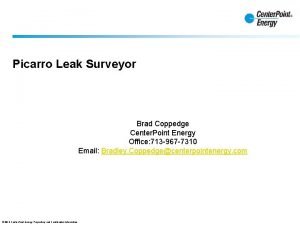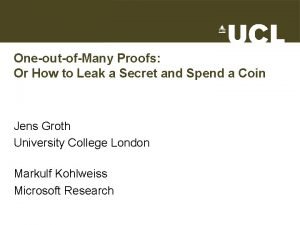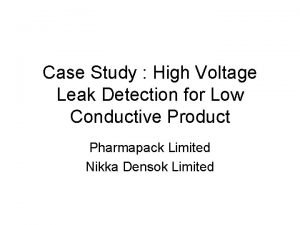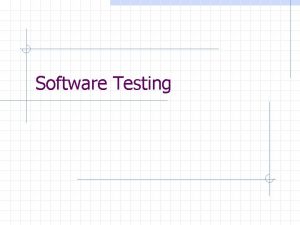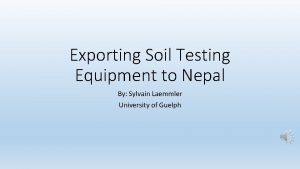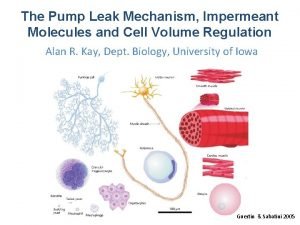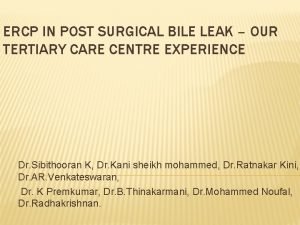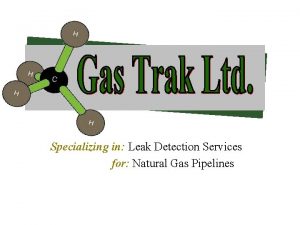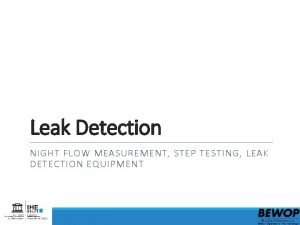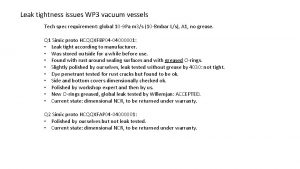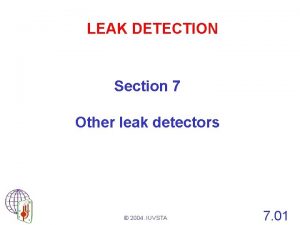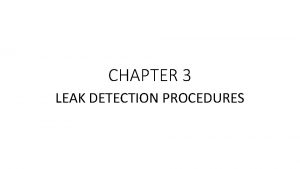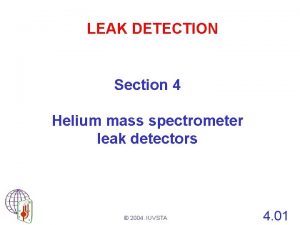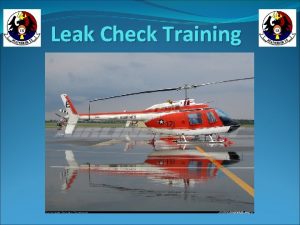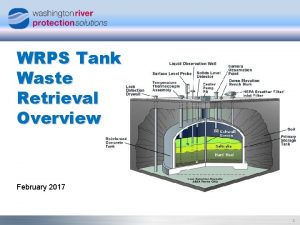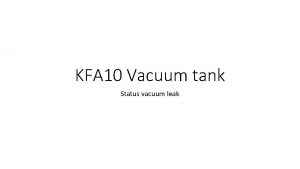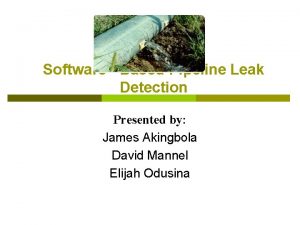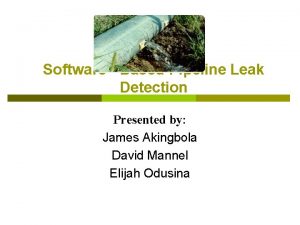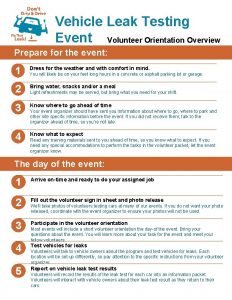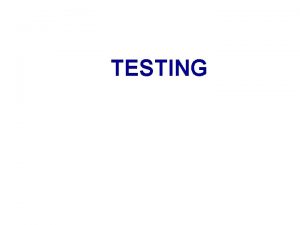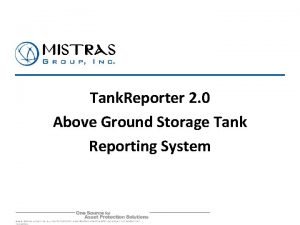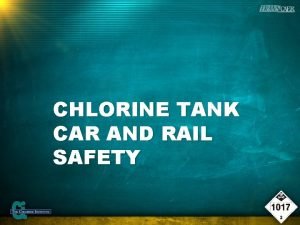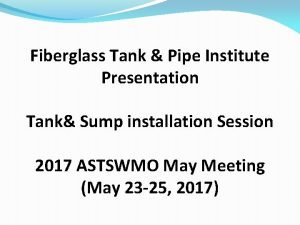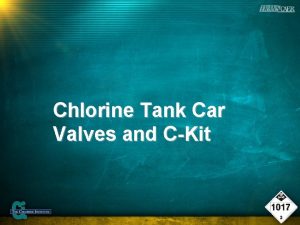Leak Detection Equipment Tank Tightness Testing Overview Presented


































- Slides: 34

Leak Detection Equipment Tank Tightness Testing Overview Presented by C. J. Schultz Tanknology Inc.

Who We Are Our Mission Tanknology is dedicated to serving the evolving needs of underground storage tank (UST) owners/operators by providing the broadest range of testing, inspection, engineering services and forecourt compliance management. We will provide superior value to our customers through highly qualified people, advanced technologies, environmental regulatory knowledge, and unwavering commitment to service, quality, and integrity.

Tanknology At a Glance Founded in 1988, Tanknology has grown to become the largest forecourt compliance testing and inspection services company in the World. Our fleet of 125 vehicles provides service in all 50 states domestically, and we have a presence in more than 30 countries, 6 continents through international licensees. We hold 22 patents covering our test equipment and various leak detection methodologies.

Underground Storage Tank Sites

Underground Storage Tank Site

E. P. A. Regulatory Requirements “Tightness Test” Requirements: • Capable of Detecting 0. 1 gph leak • 3 rd-Party Certification • Must be evaluated to meet EPA protocols by independent (3 rd-party) testing laboratory • Performance Standards • Probability of Detection at least 95% • Must Find 95% of all leaks of 0. 1 gph or more • Probability of False Alarm less than 5% • Can Report a leak on less than 5% of “tight” tanks

What Size Leak? • 0. 1 Gallons per Hour is equivalent to: • 1 can of soft drink in an hour • 6 ml per minute • A drop per second • In a large underground tank, that’s a very small leak.

How Big of an Impact? • 0. 1 Gallon per Hour is equivalent to: • 72 gallons per month • 876 gallons per year • 3316 liters per year • That much fuel can pollute a lot of groundwater! • A leak of one gallon can contaminate one million gallons of water.

Tank Tightness Testing

Understanding the 3 rd Party Listing of Vacu. Tect® • Method is 3 rd Party Approved by Ken Wilcox, meets US EPA tank tightness testing criteria to detect a. 1 gph leak and is currently listed on the NWGLDE website • Non-Volumetric/Underfill Testing Technology • Vacuum method using acoustic signal processor and microphone to determine tank integrity by the technician audibly listening for a leak. The amount of vacuum pulled on the tank in order to properly test the tank is dependent on site specific conditions including the height of product in the tank (inches), weight of fuel being tested (psi) and water table surrounding the tank.

NWGLDE Listing Vacu. Tect

NWGLDE Listing Discussion EZY CHEK

Individual Certification Required • Technicians must attend manufacturer training on the equipment and then renew their certification periodically. Equipment Too.

Annual Equipment Calibration/Certification Required for EZY Chek Systems • Each piece of equipment used must be sent back to the manufacturer annually for calibration and certification including: • • • Acoustic Signal Processor Microphones Water Sensor displays Digital Pressure Sensors Analog Vacuum Gauges

Tank Tightness Testing Considerations Test method, procedure, equipment and experienced personnel are all very important factors in a successful tank tightness test.

Tank Tightness Testing Considerations • • Make sure that your tester has been certified by the equipment manufacturer Make sure that equipment being used by the tester has been certified and calibrated as well

Tank Tightness Testing Methods Volumetric: Some tightness test methods are “volumetric” methods in which the change in product level is measured very precisely in milliliters or thousandths of an inch. Non- Volumetric: With non-volumetric underfill vacuum tests, the tester listens for sounds while the tank is under vacuum to determine whether or not the tank is leaking. A water sensor is used to measure any water ingress during the test.

Tank Tightness Testing Procedures Tanks must be taken out of service for the tightness testing. The downtime depends on the test method and issues encountered during testing.

Tank Tightness Testing Procedures Critical Data For Testing: • Tank information • Diameter • Material Steel/FRP • DW/SW • Water table measurements • Depth of Tanks • Calculations are input into the Vacu. Tect® program in order for the software to calculate the vacuum that must be applied.

Tank Tightness Testing Procedures Some tank testing methods require all of the measurements and calculations to be made by the tester. Other methods are highly automated. Once the tester sets up the equipment, a computer controls the measurement and analysis.

Vacu. Tect® Method INSERTION OF TEST PROBE INTO TANK FILL RISER

Tank Tightness Testing Procedures Vacu. Tect® The system applies the lowest negative pressure to create an ingress of air or water into the tank – pressure differential of -0. 5 PSI at the tank bottom.

Tank Tightness Testing Procedures Vacu. Tect® • Once the required vacuum is achieved, the technician listens for both ullage leaks (hissing sounds) and leaks below the product level (bubble signatures). • The technician also monitors the water sensor for signs of water ingress. • All signals are digitally recorded and can be transferred to Tanknology’s Headquarters for further review.

Vacu. Tect® Bubble Ingress

Water Ingress Due To Hole Below Water Table VACUTECT™ METHOD Ground Water Table Water Ingress Detected in Tank Hole in Tank Below Water Table

Air Ingress Due To Hole(s) Above Product Level VACUTECT™ METHOD Hole in Riser Pipe Hole in Vapor Recovery Pipe Hole in Vent Line Hole in Tank Air Ingress Detected in Tank

Why is Tank Tightness Testing Necessary? • Satisfy Leak Detection Requirements • Request by a regulatory authority

Why is Tank Tightness Testing Necessary? Emergency Response Testing • Monthly Monitoring Failure or Alarm • SIR (Response to unresolved Failure or Inconclusive) • ATG (Response to unresolved Failure or Inconclusive) • Interstitial Monitoring (Liquid or fuel alarm)

Why is Tank Tightness Testing Necessary? • Tank taking on water • • Avoid Phase separation Avoid Internal Corrosion

Why is Tank Tightness Testing Necessary? • Accidents

Why is Tank Tightness Testing Necessary? • Insurance

Why is Tank Tightness Testing Necessary? Emergency Response Testing • Discovery of release of regulated substances at or near UST site • Fuel or vapor in soil, wells, basements, sewers, vaults, public lands etc. • Sheen on nearby waterway

Why is Tank Tightness Testing Necessary? Construction/Upgrade/Other Testing • Prior to removal- Why $$$$ • Sale/Transfer of Property • Pre/Post-construction (Protect your investment) • Upon installation of new system

Thank You!
 Tank tightness testing
Tank tightness testing Centerpoint energy
Centerpoint energy Secret leak detection
Secret leak detection Leak detection oxford
Leak detection oxford High voltage leak detection principle
High voltage leak detection principle Definition of software testing
Definition of software testing Building tools of graph matrices
Building tools of graph matrices Motivational overview in software testing
Motivational overview in software testing Percometer
Percometer Multimeter loopback adapter
Multimeter loopback adapter Control structure testing in software testing
Control structure testing in software testing Black-box testing disebut juga sebagai behavioral testing
Black-box testing disebut juga sebagai behavioral testing Cs3250
Cs3250 Component testing is a black box testing
Component testing is a black box testing Decision table testing in software testing
Decision table testing in software testing What is domain
What is domain Decision tables testing
Decision tables testing Functional testing vs unit testing
Functional testing vs unit testing Globalization testing
Globalization testing Domain testing example
Domain testing example Decision table based testing
Decision table based testing Data flow testing strategies in software testing
Data flow testing strategies in software testing Rigorous testing in software testing
Rigorous testing in software testing Cause effect graph for triangle problem
Cause effect graph for triangle problem Materi black box testing
Materi black box testing Positive vs negative testing
Positive vs negative testing Testing blindness in software testing
Testing blindness in software testing Songheli leak
Songheli leak Memory leak and dangling pointer
Memory leak and dangling pointer Sgt. gaedeke
Sgt. gaedeke Pitot static failures
Pitot static failures Kira dusterwald
Kira dusterwald 7 days to die memory leak
7 days to die memory leak Leak biliare strasberg
Leak biliare strasberg Leak
Leak

